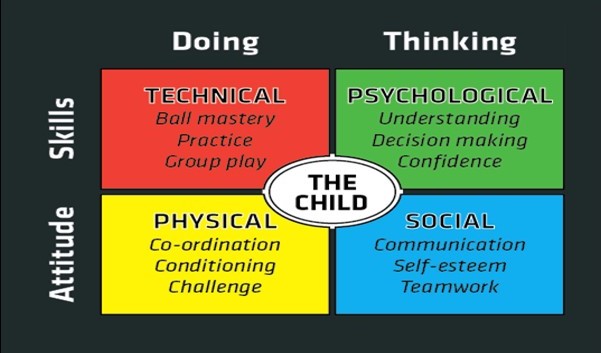

The Whole is Greater than the Sum of its Parts
First coined by the philosopher Aristotle, this phrase aptly defines the modern concept of synergy. For anyone who has played team sports, it echoes the T.E.A.M. acronym – Together, Everyone Achieves More.
Coaching grassroots needs to be way more than just teach kicking the ball around, it’s a chance of teaching players that soccer is way more than a game. When a kid joins a team, mostly of the times he’s nervous, but has a big desire to play, have fun and make friends. The club and coaches need to be conscientious of the impact that they’ll have in this kid’s future.
“A coach will impact more people in one year than the average person will in an entire lifetime.”
Billy Graham
As coaches we need to look on a Player-centric level, rather than a Team-centric. The focus should be on the individual primarily, and developing the collective of individuals you’ll develop the Team. Individuals success are moments not trophies, and those moments will affect the kids life’s on and off the field.
During a technical meeting at the club where I coach, our Technical Director once asked us: “Do you remember your third goal that you ever scored?”, all the coaches in the room started to think about it, nobody was able to come out with a answer, but after he asked “Do you remember your third coach?”, at that moment everyone was smiling and every single coach had some good stories to share. That simple question made me think about the impact that all the coaches made in my life while in sports, on my social life at the moment, my social life now and even the way that I raise my kids. I never thought about the tremendous influence that my coaches had in my life, today I’m a coach and I wish that I can deliver to my players that inspiration, those memories, those life lessons and that desire for them one day follow the same route as me becoming a coach.
Today, I’ll talk about The 4 corners of Holistic Development in soccer. What is the holistic approach?
The holistic approach looks at all aspects of the individual; physical, mental, emotional and spiritual. As coaches, our players are way more than just players, they have all kind of things going on in their life’s rather than soccer. You never know when they could be experiencing family issues, a breakup, school stress or something else that could be difficult to deal with. If the dynamic of your relationship is strictly coach-to-athlete, you will never be able to truly make an impact, and the player will be less likely to trust you on any platform.
As coaches we need to impact this kids on those 3-4 hours weekly that we have with them, but also be that role model that will last a lifetime on their heads. The holistic approach shows you that things like wins, effort and attitude will take care of themselves. Be the coach that they want to play for, that they are willing to work for, and win for. The player will be less likely to want these things if you have failed to nurture the relationship past its infantile stage.
In soccer we “break” the Holistic Development approach in 4 main areas:
- Technical/Tactical
- Psychological
- Social
- Physical
Personally, I’ll like to add another area, since during the week a coach (at grassroots) spends average of 3-4 hours with the player, it’s important to understand how everyone around this player is affecting him for the other 165 hours. Let’s call it the Village effect. I’ll talk about it later.
“It takes a whole village to raise a child” – African proverb.
How can we use the holistic approach when designing sessions?
Let’s break the concepts for easier understanding:
Technical/Tactical
- Unopposed-technique practice
- Opposed practices
- Uneven sides-skill practice e.g. 2v1, 4v2, 3v1, etc…
- Even sides-games 3v3, 4v4, 5v5, etc…
- Game craft, game as a teacher
All the technical skills need to be linked necessarily to the tactical aspects of the game.
For example, in a game a good pass, needs all the right technique to execute it (Use the inside of the foot – that’s the area from the base of the big toe to the central area of the heel, Under the ankle bone.)
- Encourage players to try new skills in practice and work out where they can be used in games,
- Practice should replicate the demands of the game and encourage players to think and make decisions just as they would in a match.
- Match the needs of the individual by altering the difficulty using the STEP principle (Space, Task, Equipment, Players).
- Use the “stop, stand still” intervention but not too much and make coaching points during a suitable break in play, letting players experience the flow of the game.
- Kick foot at right angles to the ball.
- Belly button should be facing the player receiving the pass.
- Non-kicking foot alongside the ball.
- Knee and ankle joints held firm.
- Body over the ball.
- Head steady, eyes on the ball.
- Use the arms to keep balanced.
- Hit through the ball’s horizontal midline – that way it will keep low.
- Kicking foot follows through towards the target.
But, it’s not enough, if not linked to the Tactical aspects of the passing, when, where, how and why, (timing, Weight/power and purpose of the pass). We can make 10.000 passes against a wall, if we don’t understand this questions it would be just ball movement, and never a good pass.
Target: Developing different range of techniques on and off the ball, and ball mastery.
Psychological
- Understanding
- Decision-making
- Confidence
- Concentration
- Commitment
- Practising, learning, experimenting
- Learning styles
- Relevant to the needs of the player
Use different methods of communication to engage with different types of learners.
- Visual (seeing) – session plans, tactics boards, cue and prompt cards as well as cones on a pitch.
- Auditory (hearing) – Speak with players, ask questions and encourage discussion among team-mates to solve game related problems.
- Kinetic (doing) – demonstration to the team by a coach or by a player to their team-mates.
Target: Increasing learning
Social
- Communication
- Relationship
- Are the players:
- Enjoying the work?
- Included in the process?
- Challenged? Engaged?
- Supported when necessary (visually, orally and practically)?
- Given ownerships, trust and responsibility?
- Be a good role model for the players.
- Create a positive and welcoming environment.
- Praise players for their effort and endeavour as well as abilities.
- Use descriptive praise to pinpoint what the players have done well.
- Manage mistakes to the player’s advantage – understand what they were trying to do.
- Sometimes they will have the right idea but just fail in the execution of the technique or skill.
- Make sure the sessions are enjoyable but with a purpose. Ensure the development of skills and game understanding.
Target: Enjoy and get them passionate about soccer.
Physical
- Develop physical literacy
- Generic movement skills:
- Agility, Balance, Coordination, Speed, Soccer functional movement Skills, COD speed (Changing Of Directions)
- Receiving the Ball, Running with the ball,
- Dribbling, Turning, Kicking and Heading
- Appropriate movement skills which develop agility, balance, coordination and speed through enjoyable games.
- Using well designed practices, all coaching activities should include physical outcomes.
- Allow for differing growth rates between the players and cater for the needs at both ends of the growth scale.
- Children are not mini-adults and sessions should not include laps of the pitch and press ups.
Target: Improving movement and the ABC’S
This is a simplified way to understand the 4 corners of Holistic Development in soccer.
If you remember, before this explanation, I mentioned another “concept” that I called it “Village effect”, in a very simple way, it’s everyone else that has influence on the day-by-day of the children, since parents, school teachers, family, friends, other activities coaches, neighbours, etc… All this people that surrounds the child will have a impact on his life, by words, actions, behavior or ideology.
As coaches we can’t just practice and “send them home”, we need to try to understand what is going on in their life’s, without being nosy, but this approach can actually give you some answers why the child is behave differently.
How many of us (coaches) did actually got in contact with the players teachers? How many of us attended to a player’s family party? How many of us helped or initiate a extra-soccer activity, where players get involvement in the community?
It may sound too much, but the impact of this 4+1 Holistic Development approach can help improve players to a completely different level.
(all my articles are based in my opinions and beliefs, please share with us your thoughts and opinions on the comments below).
Find more info about this subject in our online course:
Follow us on Facebook!
Leave A Reply Cancel reply
You must be logged in to post a comment.
Categories
Latest Courses
-
9 Lessons
-
1 Lesson
-
6 Lessons
You May Also Like
-
-
August 1, 2022
-
-
June 3, 2022
-
-
May 27, 2022

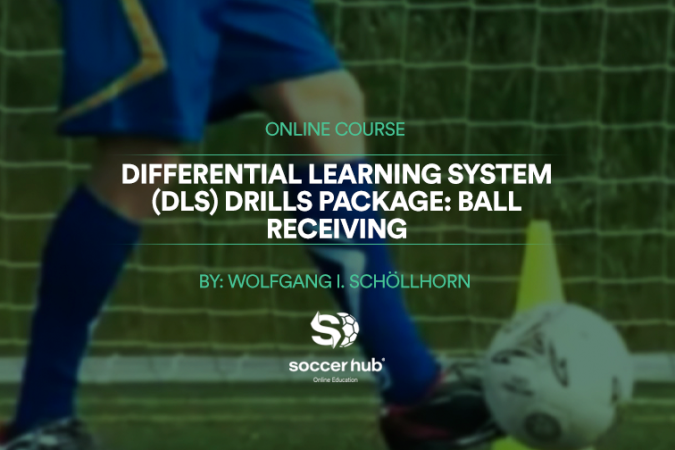
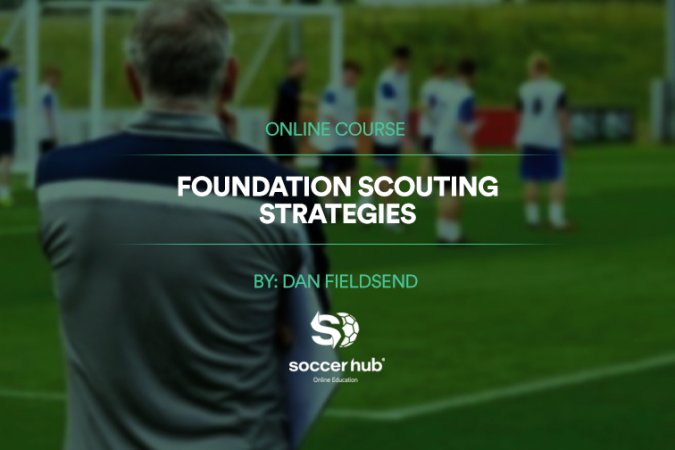
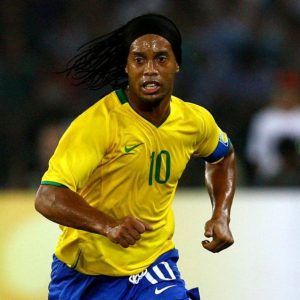
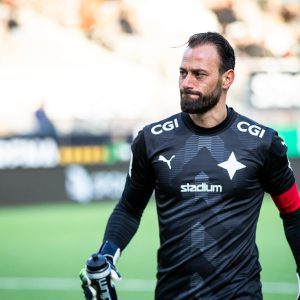
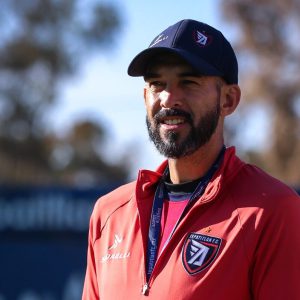
1 Comment
Great article … it really reaffirms my the knowledge I have gained throughout my 30+ years of coaching, my own experiences and the time I have spent reflecting after training and or games.
I love the approach !!! It’s the approach. In fact I don’t call it player centric I call it person centric.
My philosophy is “Striving for excellence in person centric holistic environment using modern teaching methods and tools based on my values and beliefs”